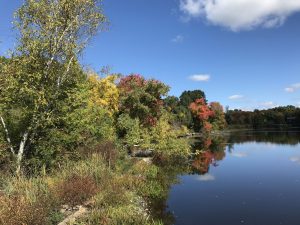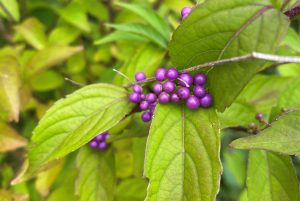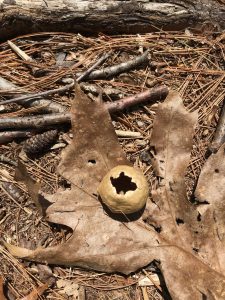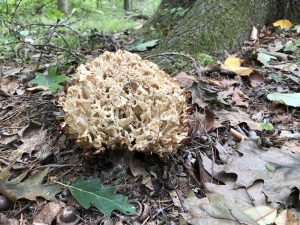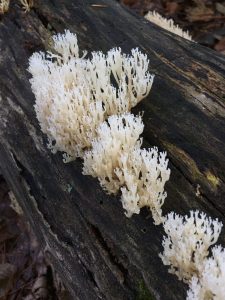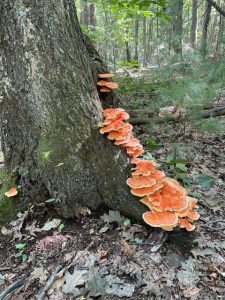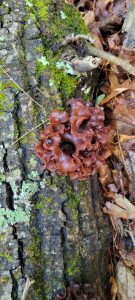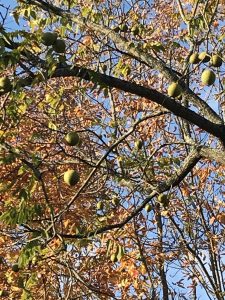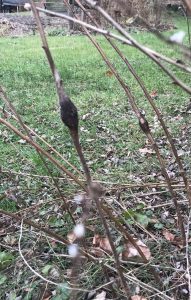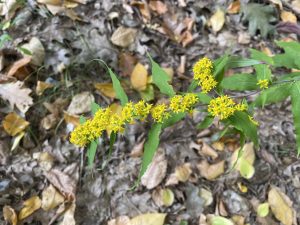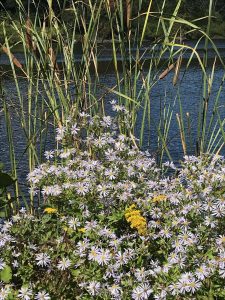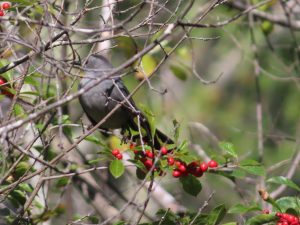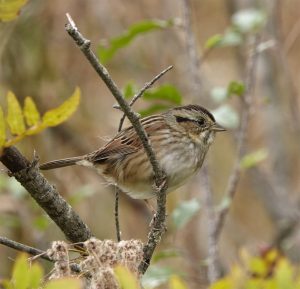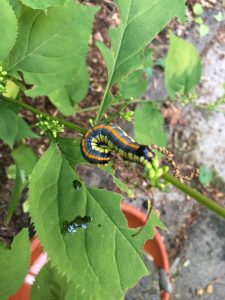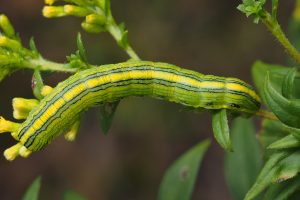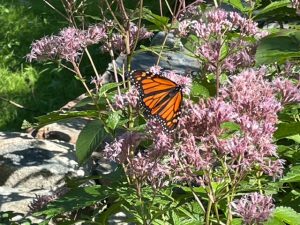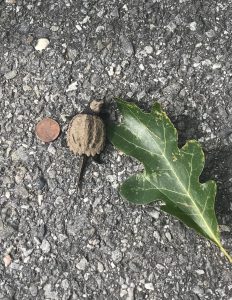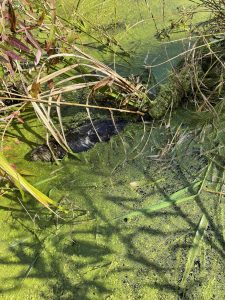Written by Gwyn Loud for the Lincoln Land Conservation Trust. She welcomes your sightings and questions at 781-259-8690 or gwynloud555@gmail.com.
The past month has seen considerable sways in temperature, with the thermometer dipping into the thirties sporadically, but also a few summery days in the seventies. We have had some days of welcome rain, but still not enough to take Middlesex County out of the “severe drought” category, and the water level in Flint’s Pond continues to drop. The watering restrictions from the summer are still in effect.
Maples are leading the way in the parade of beautiful fall colors and the display will only brighten in weeks ahead. Seeds and berries are bountiful at this season, all food for birds and mammals to feast on before the winter comes. If you come across a tree with what looks like hanging tennis balls, you have found a black walnut. Asters and goldenrods are still blooming and in the woods watch for partridge berry or jack-in-the pulpit, both with bright red berries. Galls, a symbiotic relationship between an insect and its plant host, are plant features you may come across. Goldenrod stems, for instance, often have a swollen spot where an insect such as a tiny wasp, has laid an egg, stimulating the plant to grow a “home” in which the egg can hatch and and the larva feed. If you examine the gall and see a tiny hole, that shows the larva has become an adult and flown away. Another common gall is an oak apple gall, a brown papery sphere, often found on the forest floor after the wasp inside has left. October is a great month to look for fungi, especially after rain. Just don’t eat mushrooms unless you are SURE they are not poisonous!
This tends to be garden clean-up time. As we each ponder climate change and what to do, please consider leaving some plants with seed heads standing in flower beds and leaves lying as mulch below trees and shrubs. Insects, birds, and small mammals, all essential to healthy ecosystems, find food and shelter in such “untidy” places, and leaf mulch benefits trees, holding in moisture and providing nutrients as it naturally decomposes. If you don’t like a few leaves on your lawn, try using a free leaf blower- the wind!
Birders think of October as “sparrow month”, since various sparrow species are migrating. Chipping sparrows nested here but they are assembling in flocks to head south and observers have also spotted swamp and savannah sparrows, and one vesper sparrow. White-throated sparrows are just arriving from the north and will be here all winter. Some of our summer song sparrows will also over-winter, and I await the arrival of a fox sparrow or two in November.
Fall warblers spotted recently on migration include pine, blackpoll, American redstart, prairie, black-throated green, palm, magnolia, yellow-rumped, common yellow-throat, and a lone Connecticut warbler. Ruby-crowned kinglets and golden-crowned kinglets have been busily feeding in conifers, and many red-breasted nuthatches have been seen over recent months, indicating a good winter for us to see this irruptive species. Gray catbirds and northern flickers are still here, as are Eastern phoebes, all making their way south. Dark-eyed juncos have just arrived in my garden from the north, here to stay for the next few months. Blue jays seem plentiful lately and are migrating within New England, meaning that those we see in the summer may not be the same individuals as those we see in the winter. Additional migrating species reported from Drumlin Farm include northern waterthrush, Swainson’s thrush, American kestrel, American pipit, scarlet tanager, solitary and spotted sandpipers, and on September 27, seven sandhill cranes flying overhead, an unusual event. Cornell has developed a new migration site which predicts avian migration activity each night (see link below).
Flocks of robins and grackles are passing through and some robins will over-winter here. This is also true for some bluebirds; they find plenty of berries to eat after insects and worms are no longer available. If you feed the birds, this is the time to set up your feeders so that your local birds put your feeders on their “restaurant routes”. You might enjoy participating in Project Feeder Watch, a citizen-science project running from November to April which provides data on our bird populations (details in link below).
Crickets and grasshoppers are still singing if days and evenings are warm enough. The snowy tree cricket, sometimes called the temperature cricket, chirps at regular intervals in the evening, the colder it gets the slower the chirps. By counting the number of chirps in fifteen seconds and adding 37, you get approximately the temperature in degrees Fahrenheit. Try it! Bumble bees continue to feed on flowers at this season, but if you find a sluggish one seemingly asleep on a flower it is because the temperature needs to be above 50℉ for the bee to move. Only the queen bee hibernates during the winter; the drones and worker bees die. Many Monarch butterflies have been seen over the past month, headed to the mountains of Mexico. As for caterpillars, this is when we find woolly bear caterpillars, with their black and rust bristles. They are the larvae of the Isabella tiger moth and, unlike most moths, the caterpillars overwinter as larvae, curled up in protected spots, able to survive being frozen. Come spring, they will spin cocoons, then hatch into adult moths. An observer found a very colorful caterpillar on goldenrod, a brown-headed owlet caterpillar, which will overwinter in a cocoon and then emerge as a drab brown moth. Another insect commonly found on goldenrod is the goldenrod soldier beetle, black and yellow in color. As naturalist Mary Holland writes, “Both adults and larvae produce defensive chemicals from glands in their abdomens that discourage predation from birds, bats and other small predators.”
In early October I was dismayed to come across six little dead flattened bodies of newly-hatched snapping turtles on the road. A neighbor and I also found two living ones and helped them cross to safety. To quote Mary Holland again, “For the past three months, snapping turtle eggs have been buried roughly five to ten inches deep in sandy soil (depth depends on the size of the female laying them), absorbing heat from the sun-warmed soil. Come September, the relatively few snapping turtle eggs that have avoided predation are hatching. The sex of the baby turtles correlates to the temperature of the clutch. Temperatures of 73-80 °F will produce males, slightly above and below will produce both sexes, and more extreme temperatures will produce females. The miniature snappers crawl their way up through the earth and head for the nearest pond, probably the most perilous journey of their lives.”
Turning to mammals, observers have reported river otters in several places, and many fishers, including near Pierce House. A resident on Beaver Pond Road wrote that a trail cam records “nightly visitors ranging from raccoons, opossums, and coyotes, to a fisher and fox.” Common mammals such as woodchucks, squirrels, and chipmunks, are fattening up and storing acorns and other nuts for the winter ahead. Chipmunks greet us with a variety of clucks and chipping sounds in the woods, each sound with its own meaning. A water wildlife rescue occurred a few days ago near the ‘beaver deceiver’ on Farrar Pond. A walker noticed an animal trapped underwater and sent out an alert. Paul Shorb, who lives nearby, came to the rescue, along with Ryan Brown and Will Leona, from the Conservation Dept. Paul wrote, “Its long tail seemed strangely entwined in stringy aquatic vegetation. I was able to slide that stuff off its tail. It then swam away, at first with a strange corkscrew/twirling motion. Hard to tell whether that corkscrewing was in celebration of release or a dysfunctional swimming method that got it entwined in the first place. It turned out to be what was probably a young muskrat caught in vegetation.”
Looking skyward, the main evening attractions in October are views of Jupiter, Neptune, and Saturn.
To read more about plant galls
Reminder of leaf blower regulations in Lincoln
To read avian migration predictions for Lincoln
To learn how to participate in Project Feeder Watch


